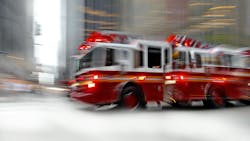What causes emergency vehicle crashes? Your first instinct might be to blame other drivers, but, hopefully, your emergency vehicle training instilled some of the risk factors that lead to crashes other than civilian drivers: vehicle type, driver’s experience and training, and environmental aspects, such as weather and intersections. Although it’s true that all of these can influence crash risk, a recent study that was conducted by Jacksonville State University introduced a new variable to help driver/operators and departments to better understand why firefighters continue to be killed and injured in vehicle crashes.
The problem
Emergency vehicle crashes continually rank as one of the most common causes of traumatic death of firefighters. Perhaps even more concerning is that when a crash involves a fire apparatus and another vehicle, the crash is 10 times more likely to kill a civilian than to kill a firefighter.
The root cause of most of these apparatus crashes commonly is traced back to human factors—i.e., the behaviors of the emergency vehicle driver. After all, the firefighters who climb into that front left seat have the most influence on crash risk when they decide the vehicle’s speed, whether to stop at intersections or whether they require passengers to buckle up, for example. That said, what factors influence the driver’s behaviors?
You might be familiar with the term sirencide—drivers get a sense of invincibility when they use lights and sirens, which leads to aggressive driving. The term was coined by the U.S. Fire Administrator in a letter to the National Transportation Safety Board chair following a train derailment that was caused by a responding pumper in 1989. While en route to an automobile fire, the pumper drove into the path of an Amtrak train near Catlett, VA. The train was derailed, two firefighters on the pumper were killed, and dozens of passengers were injured. An automobile fire that likely would have been handled by a couple of companies turned into a large-scale incident that involved surrounding counties and federal agencies.
Although the sound of sirens affects drivers’ emotions, perhaps what plays a larger role in a driver’s behavior is the sense of urgency to get to the scene. A recent study examined fatal crashes of firefighters during responses by asking a unique question: What was the firefighter responding to when a fatal crash occurred? The study reviewed the fatality narratives from the U.S. Fire Administration’s line-of-duty deaths over a 20-year period (2000–2019). After cataloguing each crash that led to the death of a responding firefighter, two other components were considered: the number of units that typically respond to each type of incident, because some assignments typically require more units than others, such as a structure fire compared with a downed tree; and the average number of responses to each type of incident, because you would expect the most common type of response to involve more crashes. The results were interesting but perhaps not surprising.Risks and responses
Although fires make up less than 12 percent of all responses by U.S. fire departments, those responses disproportionately account for more than 55 percent of all crashes that lead to a firefighter fatality. Of fire responses, structure fire responses topped the charts as the most dangerous: Firefighters are nearly 20 times more likely to be killed in a crash when they respond to a structure fire than to an EMS call. Near the top of the list were responses to rescues and entrapments: These pose nearly nine times more risk of fatal crash compared with an EMS call where a rescue isn’t involved (e.g., chest pain, difficulty breathing, etc.).
Although emergency medical calls make up the majority of the responses that are turned out by fire departments, they actually are some of the least likely responses to encounter a serious apparatus crash.
Two other interesting findings from the study: The most common type of vehicle that firefighters used for response was their personal vehicle, and the duty-status of the crashes was nearly 85 percent volunteer, which is disproportionate based on the number of responses by volunteer versus career departments.
Driving under emotion
So, what is causing this increased crash risk while en route to fires and rescues? Do members respond with the same urgency to every dispatch? Most in the fire service would admit to a casual stroll to the apparatus for a routine medical call or automatic fire alarm but pick up the pace when they hear “fire.” What about if they hear that people are entrapped?
The explanation might be in members’ emotional state: Some dispatches cause more emotion than others, and increased stress can affect one’s ability to drive safely. Further, increased crash risk correlates with studies of heart rates at the time of dispatch to fires and rescues: When members know that their skills might be put to the test, emotions are raised.
It’s well established that firefighters experience a rush of adrenaline at the time of dispatch. Although some of that feeling is linked to simply being startled, much more is based on hearing the incident type. It likely comes as no surprise that firefighters have high stress levels when they are dispatched to fires and to incidents that might require rescue or extrication. Most of us are familiar with this feeling as the fight-or-flight response to stressful situations. When our ancestors were confronted by a hungry bear, their bodies instantly prepared them: One of those two options was vital for their survival. Unfortunately, these elevated stress levels aren’t always beneficial to our modern survival.
When a circumstance arises in which our emotions are hyperelevated, it negatively affects our performance. One study that examined firefighters’ mental acuity under stress found that stress significantly impairs cognition—which can affect members’ ability to drive safely, at a time when fine motor skills and situational awareness are most needed. A driver who is under acute stress is more likely to unknowingly take unnecessary and excessive risks. Because stress affects judgment, stressed drivers lose their ability to accurately estimate speed and distance between objects. Stress also leads to more aggressive driving, such as rushing through intersections and passing in improper places.
Managing emotions
The most reasonable explanations for spikes in crash risk are the aroused emotional state and the sense of urgency that stem from the nature of dispatch. The aforementioned train derailment was blamed on these exact phenomena. In the aviation industry, these are referred to as external pressures. These influences on pilots can include an urgency to arrive to a destination by a certain time and pressures from passengers to depart when the weather conditions are marginal, among others. In fact, awareness of these external pressures and their detriment on a pilot’s judgment are incorporated into basic private-pilot training.
The best example of the effects of external pressures comes from aeromedical flights. To prevent pilots from taking unnecessary risks, the Federal Aviation Administration directs that the details of the patient be withheld from pilots until after they make a prudent decision to launch and the aircraft is safely airborne. This is intended to prevent pilots from being coerced into flying when conditions are unsafe for flight. Although it might not be a popular idea in the fire service, this concept could warrant consideration for dispatching.
Managing the acute stress that occurs after a dispatch is possible, and that, in turn, can increase members’ situational awareness and reduce their risk.
The stress-management technique box breathing has been used by the military, law enforcement and emergency department physicians to control the physiological effects of acute stress. The technique simply requires a person to inhale deeply over four seconds, hold the breath for four seconds, exhale deeply over four seconds, wait for four seconds, then repeat the cycle. This practice can reduce one’s heart rate and, in turn, reduce stress levels, to regain situational awareness.
Fortunately, the fire service is in the midst of adopting a culture of managing risk that’s based on the viability of the outcome. Although there are times that risk is warranted, members can’t assume that risk until the apparatus arrives safely at the incident. Drivers should make an effort to use this awareness of the effect of external pressures to learn to tune them out while they focus on arriving safely at the incident.
Do no harm
Fires and rescues are exciting events, but “excited” shouldn’t be a word to describe any first responder’s mindset following a dispatch. Similar to the first tenet in medicine of “do no harm,” members of the fire service must keep this in mind during responses to prevent deaths of both firefighters and innocent bystanders.
About the Author

Dustin Lambert
Dustin Lambert has more than 20 years of fire and emergency services experience. Currently, he is a lieutenant for the Fairmont, WV, Fire Department. Lambert is an instructor for West Virginia Public Service Training and for the National Fire Academy and is an EMS instructor for Pierpont Community College. He holds a doctorate in emergency management from Jacksonville State University, a master's degree in safety management from West Virginia University and a bachelor's degree in occupational safety from Fairmont State University. Lambert's research expertise is in responder safety and health, focusing on human factors and emergency vehicle crashes.

